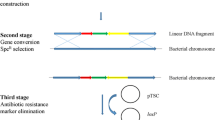Abstract
The 5-aminolevulinate (ALA) synthase gene (hemA) from Agrobacterium radiobacter zju-0121, which was cloned previously in our laboratory, contains several rare codons. To enhance the expression of this gene, Escherichia coli Rosetta(DE3), which is a rare codon optimizer strain, was picked out as the host to construct an efficient recombinant strain. Cell extracts of the recombinant E. coli were analyzed by sodium dodecyl sulfate-polyacrylamide gel electrophoresis under the appropriate conditions. The results indicated that the activity of ALA synthase expressed in Rosetta(DE3)/pET-28a(+)-hemA was about 20% higher than that in E. coli BL21(DE3). Then the effects of precursors (glycine and succinate) and glucose, which is an inhibitor for ALA dehydratase as well as the carbon sources for cell growth, on the production of 5-aminolevulinate were investigated. Based on an optimal fed-batch culture system described in our previous work, up to 6.5 g/l (50 mM) ALA was produced in a 15-l fermenter.








Similar content being viewed by others
References
Kennedy, J. C., Pottier, R. H., & Pross, D. C. (1990). Photodynamic therapy with endogenous protoporphyrin IX: basic principles and present clinical experience. Journal of Photochemistry and Photobiology B: Biology, 6, 143–148. doi:10.1016/1011-1344(90)85083-9.
De Dominicis, C., Liberti, M., Perugia, G., De Nunzio, C., Sciobica, F., Zuccala, A., et al. (2001). Role of 5-aminolevulinic acid in the diagnosis and treatment of superficial bladder cancer: improvement in diagnosis sensitivity. Urology, 57, 1059–1062. doi:10.1016/S0090-4295(01)00948-7.
Chen, H. M., Chen, C. H., Yang, H., Kuo, M. Y., & Kuo, Y. S. (2004). Successful treatment of oral verrucous hyperplasia with topical 5-aminolevulinic acid-mediated photodynamic therapy. Oral Oncology, 40, 630–637. doi:10.1016/j.oraloncology.2003.12.010.
Sasikala, C. H., Ramana, V., & Raghuveer, R. P. (1994). 5-Aminolevulinic acid: a potential herbicide/insecticide from micro-organism. Biotechnology Progress, 10, 451–459. doi:10.1021/bp00029a001.
Sasaki, K., Watanabe, M., Tanaka, T., & Tanaka, T. (2002). Biosynthesis, biotechnological production and applications of 5-aminolevulinic acid. Applied Microbiology and Biotechnology, 58, 23–29. doi:10.1007/s00253-001-0858-7.
Vladimir, Y. B., Demain, A. L., & Zaitseva, N. I. (1997). The crucial contribution of starved resting cells to the elucidation of the pathway of vitamin B12 biosynthesis. Critical Reviews in Biotechnology, 17, 21–37. doi:10.3109/07388559709146605.
Xie, L., Hall, D., Eiteman, M. A., & Altman, E. (2003). Optimization of recombinant aminolevulinate synthase production in Escherichia coli using factorial design. Applied Microbiology and Biotechnology, 63, 267–273. doi:10.1007/s00253-003-1388-2.
Lee, D. H., Jun, W. J., Shin, D. H., Cho, H. Y., & Hong, B. S. (2005). Effect of culture conditions on production of 5-aminolevulinic acid by recombinant Escherichia coli. Bioscience, Biotechnology, and Biochemistry, 69, 470–476. doi:10.1271/bbb.69.470.
Liu, X. X., Lin, J. P., Qin, G., & Cen, P. L. (2005). Expression a new hemA gene from Agrobacterium radiobacter in Escherichia coli for 5-aminolevulinate production. Chinese Journal of Chemical Engineering, 13, 522–528.
Chung, S. Y., Seo, K. H., & Rhee, J. I. (2005). Influence of culture conditions on the production of extra-cellular 5-aminolevulinic acid (ALA) by recombinant E. coli. Process Biochemistry, 40, 385–394. doi:10.1016/j.procbio.2004.01.024.
Liu, X. X., Lin, J. P., & Cen, P. L. (2006). Effect of inducers on the production of 5-aminolevulinic acid by recombinant Escherichia coli. Preparative Biochemistry & Biotechnology, 36, 223–233. doi:10.1080/10826060600716638.
Fu, W. Q., Lin, J. P., & Cen, P. L. (2007). 5-Aminolevulinate production with recombinant Escherichia coli using a rare codon optimizer host strain. Applied Microbiology and Biotechnology, 75, 777–782. doi:10.1007/s00253-007-0887-y.
Drolet, M., & Sassarman, A. (1991). Cloning and nucleotide sequence of the hemA gene of Agrobacterium radiobacter. Molecular Genetics and Genomics, 226, 250–256.
Qin, G., Lin, J. P., Liu, X. X., & Cen, P. L. (2006). Effects of medium composition on production of 5-aminolevulinic acid by recombinant Escherichia coli. Journal of Bioscience and Bioengineering, 102, 316–322. doi:10.1263/jbb.102.316.
Brinkmann, U., Mattes, R. E., & Buckel, P. (1989). High-level expression of recombinant genes in Escherichia coli is dependent on the availability of the dnaY gene product. Gene, 85, 109–114. doi:10.1016/0378-1119(89)90470-8.
Seidel, H. M., Pompliano, D. L., & Knowles, J. R. (1992). Phosphonate biosynthesis: molecular cloning of the gene for phosphoenolpyruvate mutase from Tetrahymena pyriformis and overexpression of the gene product in Escherichia coli. Biochemistry, 31, 2598–2608. doi:10.1021/bi00124a021.
Rosenberg, A. H., Goldman, E., Dunn, J. J., Studier, F. W., & Zubay, G. (1993). Effects of consecutive AGG codons on translation in Escherichia coli, demonstrated with a versatile codon test system. Journal of Bacteriology, 175, 716–722.
Nakamura, Y., Gojobori, T., & Ikemura, T. (2000). Codon usage tabulated from international DNA sequence databases: status for the year 2000. Nucleic Acids Research, 28, 292. doi:10.1093/nar/28.1.292.
Lascelles, J. (1978). Regulation of pyrrole synthesis. In R. K. Clayton, & W. R. Sistrom (Eds.), Photosynthetic Bacteria (p. 795). New York: Plenum.
Lee, D. H., Jun, W. J., Kim, K. M., Shin, D. H., Cho, H. Y., & Hong, B. S. (2003). Inhibition of 5-aminolevulinic acid dehydratase in recombinant Escherichia coli using D-glucose. Enzyme and Microbial Technology, 32, 27–34. doi:10.1016/S0141-0229(02)00241-7.
Fu, W. Q., Lin, J. P., & Cen, P. L. (2008). Enhancement of 5-aminolevulinate production with recombinant Escherichia coli using batch and fed-batch culture system. Bioresource Technology, 99, 4864–4870. doi:10.1016/j.biortech.2007.09.039.
Burnham, B. F. (1970). σ-Aminolevulinic acid synthase (from Rhodopseudomonas sphaeroides). Methods in Enzymology, 17A, 195–204. doi:10.1016/0076-6879(71)17179-0.
Laemmli, U. K. (1970). Cleavage of structural proteins during the assembly of the head of bacteriophage T4. Nature, 227, 680–685. doi:10.1038/227680a0.
Acknowledgements
This work was supported by a grant from the National Natural Science Foundation of China (20306026) and by a grant from the Ministry of Science and Technology of China (National Basic Research Program of China, 2007CB707805).
Author information
Authors and Affiliations
Corresponding author
Rights and permissions
About this article
Cite this article
Fu, W., Lin, J. & Cen, P. Expression of a hemA Gene from Agrobacterium radiobacter in a Rare Codon Optimizing Escherichia coli for Improving 5-aminolevulinate Production. Appl Biochem Biotechnol 160, 456–466 (2010). https://doi.org/10.1007/s12010-008-8363-4
Received:
Accepted:
Published:
Issue Date:
DOI: https://doi.org/10.1007/s12010-008-8363-4




